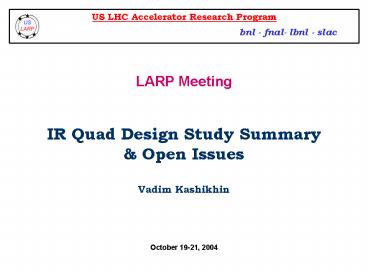Cost and Schedule PowerPoint PPT Presentation
1 / 12
Title: Cost and Schedule
1
US LHC Accelerator Research Program
bnl - fnal- lbnl - slac
LARP Meeting
IR Quad Design Study Summary Open Issues
Vadim Kashikhin October 19-21, 2004
2
RD questions
- We studied different designs of Nb3Sn quadrupoles
to address the following questions - What are the aperture limitations for the single
and double bore configurations? - What are other limiting factors?
- What field quality can be achieved?
- What are the possible coil/yoke designs?
- What are the operation margins?
- What are the conductor requirements?
3
Single-bore shell type magnets
The aperture limitations were studied for the
shell type IRQ with Jc(12T,4.2K) 3kA/mm2 and
Bpeak15T. Shell type magnets with 90-110 mm
apertures meet our goals for the maximum gradient
and field quality. The 100-110-mm aperture is the
upper limit for a magnet with the nominal
gradient of 205 T/m and 20 quench margin. The
90-100-mm designs can employ 2-3-4 layer coils,
and the 110 mm design require 3-4 layer coils.
4
Single-bore racetrack type magnets
- The racetrack designs with closed and open
midplanes were studied and compared with the
equivalent shell type magnets. - The racetrack quadrupoles are less effective than
the shell type designs with the equivalent
apertures by all the major parameters, including
gradient, field quality, coil volume, etc. - Due to the coil size limitations, the racetrack
design is not appropriate for the 2-in-1
configuration.
5
Double-bore magnets
- The 2-in-1 quadrupole limitations were studied
from the geometrical and field quality viewpoint. - The 2-in-1 quadrupole can accommodate a maximum
bore of 100 mm for the beam separation distance
of 194 mm. - Asymmetric coils with a warm or cold iron yokes
control the geometrical field quality and the
yoke saturation effect. - The warm yoke design has smaller cryostat size,
but the cold mass should be precisely centered
within the yoke. The cold yoke design has smaller
coil asymmetry and is not affected by the
eccentricity forces.
6
Thermal margin and quench protection
The Nb3Sn magnet designed with 20 quench margin
can withstand 40 mW/cm3 of peak power
dissipation in the midplane turns at
Top1.95K. The 90-100 mm magnets can be protected
with the quench heaters.
7
Design study for the short quadrupole model
- Constrains
- 90-mm aperture
- Maximum use of the existing tooling and
technology - - Bladder and key design (LBNL)
- - MQXB collars and iron yoke (FNAL).
8
4-layer quadrupole for the bladder and key
mechanical structure
9
2-layer quadrupole for the MQXB mechanical
structure
10
3-layer quadrupole for the MQXB mechanical
structure
11
3D magnetic analysis of the 90-mm IRQ in MQXB
structure
Optimized coil ends peak field is in the
straight section. Integral field optimization
will be done for the 1-wedge design.
12
Open issues questions for FY05
Determine ranges for the nominal gradient,
aperture and magnet length based on the possible
IR designs (for the single-bore
case). Development of the first version of the
field error tables (using statistics from 4-6 WR
Nb3Sn magnets). Analysis of the Nb3Sn model
magnet RD data (conductor, mechanics, quench
protection and flux jump studies) in order to
find the magnet design limitations.

